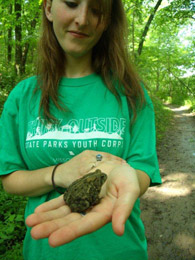 As any parent knows, the shortest distance between two points isn’t always a straight line. The more important the point to be made, the more this axiom applies. Rather than decreeing self-evident truth to young people, the planting of the seed of an idea and leading by example more often yields the desired result. One simply cannot tell a child, You will enjoy such and such a sport or other activity. This is especially true in imparting an appreciation of nature. Sometimes the best we can do is provide the entre—be it a field trip to a nature center, a canoe trip, or even a week at summer camp. Chances are the parents won’t be present when the epiphany occurs—or it might take years to take hold. But it will.
As any parent knows, the shortest distance between two points isn’t always a straight line. The more important the point to be made, the more this axiom applies. Rather than decreeing self-evident truth to young people, the planting of the seed of an idea and leading by example more often yields the desired result. One simply cannot tell a child, You will enjoy such and such a sport or other activity. This is especially true in imparting an appreciation of nature. Sometimes the best we can do is provide the entre—be it a field trip to a nature center, a canoe trip, or even a week at summer camp. Chances are the parents won’t be present when the epiphany occurs—or it might take years to take hold. But it will.
The cover story of the July issue of Parks & Recreation explores the emergence of youth conservation corps across the country. “Corps” tends to be a catch-all term describing the summer programs that put young people to work in parks in exchange for minimum wage and significant experience. On a superficial level, it’s a summer job. Which is a little like saying Central Park is just another park. They also learn job skills—from the typical, such as punctuality and responsibility, to the task specific, working with tools to accomplish meaningful tasks. At the same time, they are truly out of doors—in all kinds of weather soaking in the sights, sounds, and smells of nature. The Missouri State Parks Youth Corps even teaches its members how to become nature interpreters, and in turn they work with younger kids to foster an appreciation of nature. As Missouri State Parks Director Bill Bryan explains in the article, some kids return the next summer for more exposure while still others become seasonal employees for his park system.
Bryan describes the emergence of Youth Conservation Corps as a growing trend—state by state. When you consider their ancestral roots, the Depression-era Civilian Conservation Corps, such an assessment is refreshing. The CCC helped a generation of young unemployed men and produced a physical legacy of parks, trails, and other outdoor features that we appreciate to this day. That's a tradition that may well see new life going forward, if a proposal sent to members of Congress by the National Recreation and Park Association and the National Association of State Park Directors this week gets the attention it deserves. NRPA urges the creation of a Conservation Construction Corps--a national employment program to put Americans back to work and revitalize local, state, and national parks in the United States. The reborn corps would create jobs for skilled, out-of-work citizens, while providing needed repairs to the country's aging public parks and recreation facilities, including sanitation systems, deteriorating building exteriors, and access roads/bridges. That's no small order, but then again, the present-day precedent is there in the youth corps.
We’re a richer country for the tradition created by the CCC, and just perhaps we can regain some of that conservation esprit de corps with today’s youth organizations. The seeds of appreciation for nature and the outdoors have been planted and hopefully will yield a larger generation of nature-savvy citizens.
Phil Hayward is the Editor for Parks & Recreation magazine.

